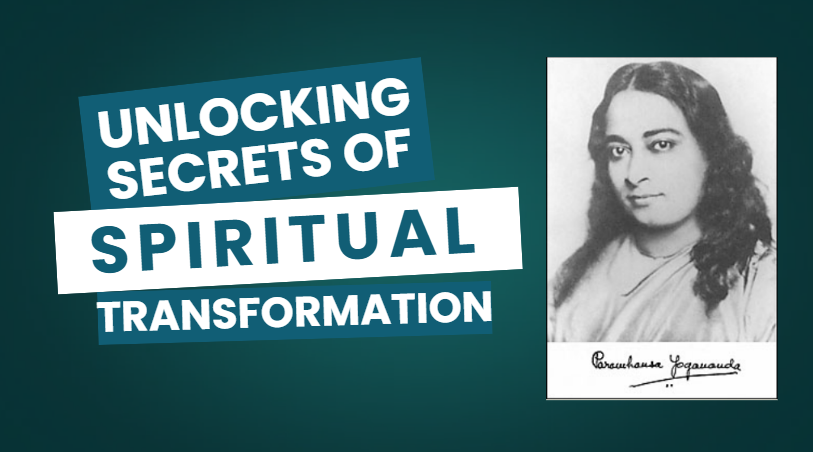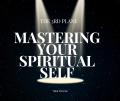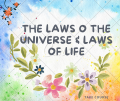
Autobiography of a Yogi recounts the spiritual journey of Paramhansa Yogananda, detailing his encounters with numerous saints and gurus in India and his eventual journey to the United States to share his teachings. The narrative explores Yogananda’s spiritual development, his experiences with Kriya Yoga, and his interactions with significant figures like Lahiri Mahasaya and Babaji. The book also features anecdotes of miraculous healings and spiritual insights, highlighting the power of yoga and meditation. Furthermore, it touches upon the author’s experiences in America, introducing Western readers to Indian spirituality and promoting interfaith dialogue. Ultimately, the autobiography serves as a testament to the transformative power of spiritual practice and the universality of religious experience.
FAQ: Key Themes from “Autobiography of a Yogi”
- What is the significance of a guru in the spiritual journey, according to this text?
- The guru is portrayed as an essential guide, a living manifestation of God, who provides not just intellectual understanding but also direct spiritual experience. A guru like Sri Yukteswar offers personalized instruction, unwavering discipline to overcome character flaws, and helps the disciple realize their spiritual potential. He acts as a “spiritual radio,” both receiving and transmitting spiritual energy and wisdom, and bestows upon his disciples the means to realize their own true nature. The guru is not merely a teacher but a transformative force, leading the disciple to liberation.
- What role do practices like yoga and meditation play in spiritual development?
- Yoga and meditation are presented as scientific techniques for achieving union with the Divine. These practices are not just physical or mental exercises, but tools for stilling the sensory tumult, achieving concentration, and realizing an ever-increasing identity with cosmic consciousness. Kriya Yoga in particular is mentioned as a powerful practice for spiritual illumination. Through dedicated practice, one can transcend the limitations of the physical and mental realms and access deeper truths. These practices also cultivate the will power needed to overcome base desires and worldly attachments.
- How is the concept of “miracles” or extraordinary abilities explained?
- The text explains that what is commonly perceived as “miracles” are actually the result of yogic mastery over natural laws. These “miracles” are not supernatural but rather demonstrate the subtle unity of the phenomenal world and the ability of advanced yogis to transcend the limitations of time, space, and matter. This mastery stems from a deep understanding of the underlying cosmic energy and the interconnectedness of all things. The ability to manifest objects, read minds, or travel instantaneously is not a sign of magic but rather a demonstration of the yogi’s access to the deeper realities of existence.
- What is the nature of the soul and its relationship with God?
- The soul is described as the pure, changeless image of God, the divine essence within each individual. It is beyond physical or gender distinctions. The text emphasizes that every person, in their individuality, is essential to the universal structure and has the potential for union with the Divine. The journey of spiritual evolution involves realizing this inherent divinity and overcoming the illusion of separateness from God, which occurs when the soul identifies with the ego.
- What does the book suggest about dealing with worldly desires and temptations?
- The book suggests a balanced approach to desires, emphasizing mastery and self-control. Desires, such as the sex instinct, are not inherently bad but should be used for their intended purpose and not allowed to become insatiable longings. It teaches that true happiness comes not from material gratification but from inner peace. The path involves cultivating an indomitable will, impersonal analysis, and using natural passions for spiritual growth rather than succumbing to them. Self-control, likened to a lion, allows one to roam in the world without being overwhelmed by the “frogs of weakness.”
- How does the book view the concept of astrology, and how can it be approached constructively?
- Astrology is not viewed as an absolute, predetermined force but as a system that can be understood and even transcended. The text acknowledges the influence of planetary energies on human life, but stresses that the wise man defeats their planets by cultivating his will, prayer, and spiritual practices. Astrological influences can be mitigated by certain methods, such as wearing copper, silver, gold, and lead metals, plants, and jewels which emit an astral light that counters negative pulls of the planets. The book does not advocate a fatalistic acceptance of planetary influences, but an empowered approach to overcoming them.
- What is the significance of the concept of “samadhi” discussed in the book?
- Samadhi is presented as a superconscious state of ecstatic union with the Divine, where the yogi perceives the identity of the soul and Spirit. It’s described as a state beyond the limits of the mortal frame, a state of “all-flowing I, I everywhere,” where the distinction between self and the universe dissolves. Samadhi is not just a temporary experience but a transformative realization that one can access at will through dedicated spiritual practice. Through deeper meditation, a person gains a new level of vision, sensing the underlying reality beyond the material world.
- How does the book blend scientific and spiritual concepts?
- The text frequently draws parallels between scientific discoveries and spiritual insights, suggesting that they are different facets of the same underlying truth. For example, the atomic structure of matter as understood by ancient Hindus is presented in the context of modern science, as is the nature of light, energy, and subtle vibrations. Concepts such as the human body as a “radio,” the flow of universal energy, and the power of thought vibrations are explained with a blend of scientific and spiritual language. The book implies that a complete understanding of reality requires the integration of scientific inquiry and spiritual realization.
- Describe the author’s father’s character and habits, as mentioned in the text.
- What did the sadhu tell the author’s mother, and what was her reaction?
- Describe the experience of Kedar Nath Babu at the ghat and the explanation of the yogi.
- What was the author’s prayer, and what happened immediately after?
- Explain how the scientist used the crescograph, and what did he observe?
- What challenge did Sri Yukteswar give to the author and his friend in Agra?
- Explain how the author came to recognize Sri Yukteswar as his guru.
- What did Sri Yukteswar say about fear and the “mosquito consciousness?”
- What did Sri Yukteswar mean by comparing shallow men to oceanic minds?
- Describe the experience of samadhi that the author had with Sri Yukteswar.
Quiz Answer Key
- The author’s father was a strict disciplinarian to his children but very Spartan toward himself, avoiding luxuries and finding recreation in spiritual practices and reading. He was also open to persuasion if given good arguments.
- A sadhu told the author’s mother that her time on earth was short and her next illness would be her last. She received this news with peace and no alarm.
- Kedar Nath Babu saw the yogi wearing the same sandals at the ghat as he was wearing when he visited, even though the yogi had not left his room. The yogi explained that true yogis can see and converse with their disciples across distances.
- The author prayed to God for guidance on whether to lead a renunciate or worldly life. Immediately after, he was approached by a sadhu with a powerful presence, who called him to his side.
- The scientist used the crescograph to magnify the movements of a fern. The author observed minute life movements and how the plant reacted when touched.
- Sri Yukteswar challenged the author and his friend to go to Brindaban without money or begging, to not reveal their predicament, and to not miss any meals. They had to return before midnight.
- The author felt a sense of lifelong search being over when Sri Yukteswar consented to making his wish (to become a monk) his wish. He saw a picture of Lahiri Mahasaya and recognized his guru.
- Sri Yukteswar said that one should look fear in the face and it will cease to trouble you. He told the author to be rid of the “mosquito consciousness” and to change himself instead of the world around him.
- Sri Yukteswar compared shallow men to minds filled with little thoughts causing commotion and oceanic minds to those filled with inspiration with barely a ruffle. He implied that depth of understanding results in serenity.
- Sri Yukteswar touched the author’s chest above the heart, causing his breath to leave him, and his body became immobile, as he experienced samadhi with his soul and mind freed from physical bondage.
Essay Questions
- Discuss the role of discipline and self-control in the author’s spiritual development, citing specific examples from his interactions with his father and Sri Yukteswar.
- Analyze the concept of divine guidance as presented in the excerpts, considering various forms of revelation such as encounters with sadhus, direct communication with God, and insights from gurus.
- Explore the relationship between science and spirituality in the text, particularly focusing on the use of the crescograph and the discussion of Vaisesika philosophy.
- Compare and contrast the different roles and characteristics of various spiritual figures mentioned, such as Lahiri Mahasaya, Babaji, and Ram Gopal Muzumdar.
- Explain the concept of samadhi as described in the text, and its significance for the author’s spiritual growth. Discuss the various ways it is attained and experienced.
Glossary of Key Terms
- Sadhu: A Hindu ascetic or holy man who has renounced worldly life.
- Babu: (Bengali) Mister, a title of respect placed at the end of a name.
- Bhagavad Gita: A sacred Hindu scripture, part of the Mahabharata, considered to be of paramount importance in Hindu spiritual and philosophical traditions.
- Yogi: A practitioner of yoga, a system of physical, mental, and spiritual practices.
- Samadhi: A state of superconsciousness in which the yogi perceives the identity of soul and Spirit.
- Ghat: A flight of steps leading down to a river, typically used for bathing and religious ceremonies.
- Vaisesika: One of the six systems of Indian philosophy focusing on atomic theory and metaphysics.
- Sanskrit: An ancient Indo-Aryan language, the sacred language of Hinduism.
- Raga: In Indian classical music, a melodic framework for improvisation.
- Tala: In Indian classical music, a rhythmic pattern, often complex.
- Intuition (Agama): Direct knowledge gained through soul perception.
- Sat: Being, essence, or reality; also a reference to truth.
- Sanga: Association or fellowship.
- Pundit: A scholar, typically of Hindu law or scriptures.
- Ashram: A hermitage or spiritual retreat.
- Guru: A spiritual teacher, guide, or mentor.
- Kriya Yoga: A specific yogic technique for spiritual advancement.
- Dhoti: A traditional garment worn by men in South Asia; a cloth wrapped around the waist and legs.
- Hari: An endearing name by which Lord Krishna is known to his devotees.
- Diksha: Spiritual initiation, a dedication to the path.
- Devanagari: The script in which Sanskrit and many other Indian languages are written.
- Bhasyas: A commentary on a particular text, often used in Indian philosophy and religion.
- Mahabharata: A major Sanskrit epic of ancient India.
- Upanishads: A collection of philosophical and spiritual texts forming part of the Vedas, the sacred scriptures of Hinduism.
- Swami: A Hindu monk, typically belonging to a monastic order.
- Yugas: The four ages in the Hindu cosmological time cycle: Satya, Treta, Dwapara, and Kali Yugas.
- Satyagraha: A philosophy and practice of non-violent resistance, most notably used by Mahatma Gandhi.
- Hiranyaloka: The “Illumined Astral Planet,” a spiritual realm where advanced beings help each other release astral karma.
Bible Search
 God Powered Affirmations and Prayers
God Powered Affirmations and Prayers IAM Higher Spiritual Powers
IAM Higher Spiritual Powers Becoming Ultimate Masters
Becoming Ultimate Masters The Power of the Mind and Positive Thought
The Power of the Mind and Positive Thought Achieving and Retaining Abundance and satisfaction
Achieving and Retaining Abundance and satisfaction The 3rd Plane: Mastering Your Spiritual Self
The 3rd Plane: Mastering Your Spiritual Self Secrets to a Successful Life
Secrets to a Successful Life The Great News: Understanding the God within You
The Great News: Understanding the God within You The laws of the Universe and the Laws of LifeSpirituality
The laws of the Universe and the Laws of LifeSpirituality
 Gerald BusingeOut-of-Body Experiences and the Nature of Reality by Darius J Wright
Gerald BusingeOut-of-Body Experiences and the Nature of Reality by Darius J Wright Gerald BusingeOut-of-Body Experiences and the Nature of Reality by Darius J Wright
Gerald BusingeOut-of-Body Experiences and the Nature of Reality by Darius J WrightKathieOut-of-Body Experiences and the Nature of Reality by Darius J Wright
Harry StevensonOut-of-Body Experiences and the Nature of Reality by Darius J Wright
The 3rd Plane: Mastering Your Spiritual Self
Jáckson Patrick Nnamdi ÁchusimThe Eye of the I: from which nothing is hidden by David R Hawkins
The laws of the Universe and the Laws of Life
The Science of Getting Rich - The Ultimate MastersHow to Observe the Cosmic Law: Guidance from the Angels and Spiritual Hierarchy
 Through the Gates of Good: James Allen’s Path to RighteousnessPower of God
Through the Gates of Good: James Allen’s Path to RighteousnessPower of God Thought Vibration and the Law of AttractionPhysical wellbeing
Thought Vibration and the Law of AttractionPhysical wellbeing Think and Grow Rich: Napoleon Hill’s PrinciplesMental wellbeing
Think and Grow Rich: Napoleon Hill’s PrinciplesMental wellbeing Tao Te Ching (McDonald Translation)General
Tao Te Ching (McDonald Translation)General Secret Door to Success: Spiritual Laws and Practical WisdomPhysical wellbeing
Secret Door to Success: Spiritual Laws and Practical WisdomPhysical wellbeing I AM Discourses: The Seven Mighty ElohimProsperity
I AM Discourses: The Seven Mighty ElohimProsperity The Power of the Spoken Word: Scovel Shinn’s GuidePower of God
The Power of the Spoken Word: Scovel Shinn’s GuidePower of God Power Versus Force: Anatomy of ConsciousnessMental wellbeing
Power Versus Force: Anatomy of ConsciousnessMental wellbeing Out From The Heart: Mastering the Inner LifeProsperity
Out From The Heart: Mastering the Inner LifeProsperity New Thought Healing Made Plain: A Guide to Mental силыProsperity
New Thought Healing Made Plain: A Guide to Mental силыProsperity
Featured Downloads
- Download “A common sense view of mind cure by Laura Westall” common-sense-view-of-the-mind-cure-by-Laura-Westall.pdf – Downloaded 19991 times – 1.54 MB
- Download “A movement within God by Neville Goddard” a-movement-within-god-neville-goddard.pdf – Downloaded 22158 times – 2.24 MB
- Download “Abdullah's Teachings: Manifesting Reality Through Divine Oneness” Lessons-from-ABD-Allah1.pdf – Downloaded 9792 times – 803.08 KB
- Download “Awakening the Third Eye by Samuel Sagan” Awakening-the-Third-Eye-pdf.pdf – Downloaded 18907 times – 1.96 MB
- Download “Byways to blessedness by James Allen” byways-to-blessedness-James-Allen.pdf – Downloaded 1410 times – 1.73 MB
- Download “Cosmic Power and Divine law” Cosmic-power-and-devine-law.pdf – Downloaded 15173 times – 8.20 MB
- Download “Divine Science and Healing by Malinda Cramer” divine-science-and-healing.pdf – Downloaded 31349 times – 2.59 MB
- Download “Download Above Life's Turmoil by James Allen” above-lifes-turmoil-James-Allen.pdf – Downloaded 19235 times – 1.42 MB
- Download “Download Acres of Diamonds by Russel Herman Conwell” Acres-of-Diamonds-by-Russel-Herman-Conwell.pdf – Downloaded 19731 times – 1.20 MB
- Download “Download Becoming Ultimate Masters: Harnessing your oneness with God, manifesting and having a fulfilling life” UG-Becoming-Ultimate-Masters.pdf – Downloaded 11670 times – 4.37 MB



0 responses on "The Science of Kriya Yoga: Unlocking the Secrets to Spiritual Transformation"